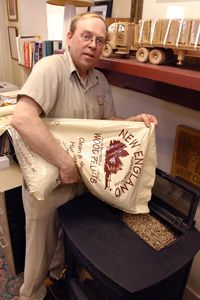What to Look for in a Wood Pellet Stove
There are many makes and models of pellet stoves, so it may be overwhelming trying to choose the best one for your home. Before purchasing your stove, make sure pellets are readily available in your area to avoid having to pay shipping costs.
Consider the square footage of the room that you want to install it in. To keep those tootsies warm, a room needs an average of 5,000 Btu output from the stove per 200 square feet of space [source: Consumer Reports]. If you get a stove that's too big, you'll end up burning the pellets on low to avoid overheating, which is not only a waste of fuel, but also a big cause of pollution. So be sure to do the math before committing to a particular model.
Advertisement
Purchase the stove only from an authorized dealer, especially if you're shopping online. If your dealer doesn't have the stamp of approval, your manufacturer's warranty may be void. Look for a label from the U.S. Environmental Protection Agency (EPA) stating that your stove has passed all inspections. Also check to make sure there's a label stating the overall efficiency range as well as the heat output in Btu. High-quality wood pellet stoves typically have an overall efficiency range of 75 to 90 percent.
Wood pellet stoves are only safe to sit on certain materials. Be sure to check with your dealer to see if your floors are OK, or if you need to purchase a different flooring material to put under your stove. If you want to be able to light the stove and walk away for the day, be sure to get one with a large hopper. And if you live in a cold area where power outages are likely to happen, consider getting a stove with a battery backup.
If you like the look of fire, look for a stove with a good flame pattern and a large viewing glass. Some models even have ceramic logs to give you the look of a traditional fireplace. Finishes include enamel, tile and marble, and if you're feeling particularly fancy, you can even get one with 24-karat gold trim.
For more information on keeping yourself warm on a budget, cozy up to the links on the following page.
Related HowStuffWorks Articles
More Great Links
Sources
- Bradford, Stacey L. "Should You Buy a Pellet Stove?" Smartmoney.com, September 2005. http://www.smartmoney.com/spending/deals/should-you-buy-a-pellet-stove-18323/
- "Buyer's Guide to Pellet and Wood Burning Stoves." Consumer Reports Blog, January 2008.
- Darling, David. "Pellet Stoves." The Encyclopedia of Alternative Energy and Sustainable Living.
- Gulland, John. "Considering a Wood Pellet Stove? Do Your Homework First." Mother Earth News, December/January 2006. http://www.motherearthnews.com/Renewable-Energy/2006-12-01/Considering-a-Wood-Pellet-Stove-Do-Your-Homework-First.aspx
- Kelly, Kevin. "Wood Pellet Stoves." Cool Tools, October 2004. http://www.kk.org/cooltools/archives/000575.php
- "Pellet Stoves." A Consumer Guide to Pellet Stoves. Woodpelletstoves.net
- Slattery, Ellen. "The low-down on wood pellet stoves." Green Daily, January 2008. http://www.greendaily.com/2008/01/09/the-low-down-on-wood-pellet-stoves/
- Vandervort, David. "Pellet Stoves Buying Guide." http://www.hometips.com. http://www.hometips.com/buying-guides/pellet-stoves.html
- "Wood and Pellet Heating." A Consumer's Guide to Energy Efficiency and Renewable Energy. December 2008, U.S. Department of Energy. http://apps1.eere.energy.gov/consumer/your_home/space_heating_cooling/index.cfm/mytopic=12570
